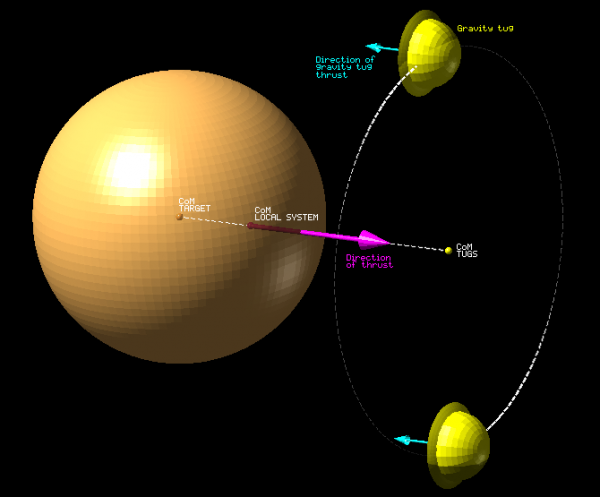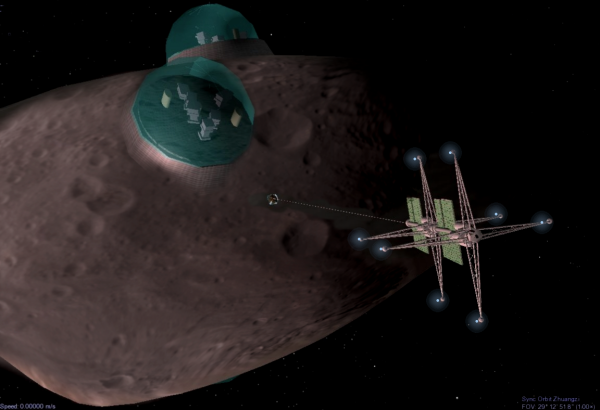BY LETTER
Gravity Tug
Technology > Application > Transportation > Interplanetary Transport
Technology > Application > Transportation > Ships
Technology > Application > Transportation > Ships
AKA Gravity Tractors | |
 Image from Alex Mulvey | |
| A common configuration for a gravity tug system uses two or more massive craft in orbit around a point forward of the asteroid itself. As the tugs exert thrust they drag the asteroid behind them, using the asteroid's own gravity | |
Gravity tugs can be utilized at all scales, from asteroids to stars. They work by placing a "tug" — a sizable mass, relative to the target to be moved — in close proximity to the target. This mass is used to manipulate the center of gravity of the local system to a point outside the target. The tug is then propelled in order to pull in the opposite direction of the center of mass, moving and steering the target. For gravity tugs, no physical contact is made between the tug and the target. The mass for the tug can be sourced from anywhere, and can still be a much smaller mass than the target in order for the system to properly function.
A basic gravity tug method involves both objects stationary relative to each other. Rather than maintaining a type of orbit, the tug with its mass remains ahead of the target and thrusts away from it, pulling the center of gravity and the target. The source of thrust must extend beyond the edges of target in order to not waste energy. If using on-board thrusters, they must fire in such a way that they avoid the target; if using external sources of thrust such as solar sails, the sails must remain exposed beyond the edges of the target.
A more advanced method involves the tug, or multiple tugs, in an orbit about a point exterior of the target. The tug thrusts constantly in the direction of intended motion, pulling the target along with it. This method has applicability at all scales but excels with larger targets; rather than needed extending arrays of infrastructure to keep thrust plumes or sails beyond the edges of the target, the entire tug itself can remain beyond the target in this zone.
The push and pull method utilizes a tug mass in a standard orbit around the center of mass of the target. The vector of intended motion lies in the plane of the tug's orbit. In this orbit, at the "rear" end of the intended motion, the tug thrusts towards the target which pushes the center of mass inward toward the desired direction of motion. On the opposite side of the orbit, at the "front", the tug thrusts again in a collinear direction as before, pulling the center of mass of the system out again and also again in the direction of intended motion, moving the entire system. This process is particularly slow, and thus infrequently utilized.
The planet can also be turned into a giant form of solar sail ship. Some methods for allowing this include using the sunlight as thrust for the first gravity tug method, or constructing a mirrored shell on or around the planet. The home star can be focused into a directed energy beam which fires at the reflectors. This method requires directed beam launchers in line with the target at both the origin and destination.
Most smaller asteroids rotate quite rapidly, and often alter their mode of rotation chaotically. Asteroids smaller than 100 metres in diameter often rotate so fast that centrifugal force could fling any craft or astronaut from the surface of the object. Somewhat larger asteroids rotate less rapidly, but are often loose piles of rubble and aggregate. This makes moving such asteroids in a controlled fashion quite difficult, but gravity tugs can achieve this without the need to de-spin the asteroid.
 Image from Steve Bowers | |
| Sometimes it is necessary to move the asteroids in Barnard's Belt. Here a pair of gravity tugs arranged in tandem are gently pulling this colonised rock to a new orbit. This variant of the gravity tug concept utilises asteroid material gathered from the asteroid itself to increase the mass of the tugs, making the process more efficient. | |
Related Articles
Appears in Topics
Development Notes
Text by Alex Mulvey and Steve Bowers
Initially published on 23 May 2008.
Updated 2021 by Alex Mulvey
Initially published on 23 May 2008.
Updated 2021 by Alex Mulvey
Additional Information






